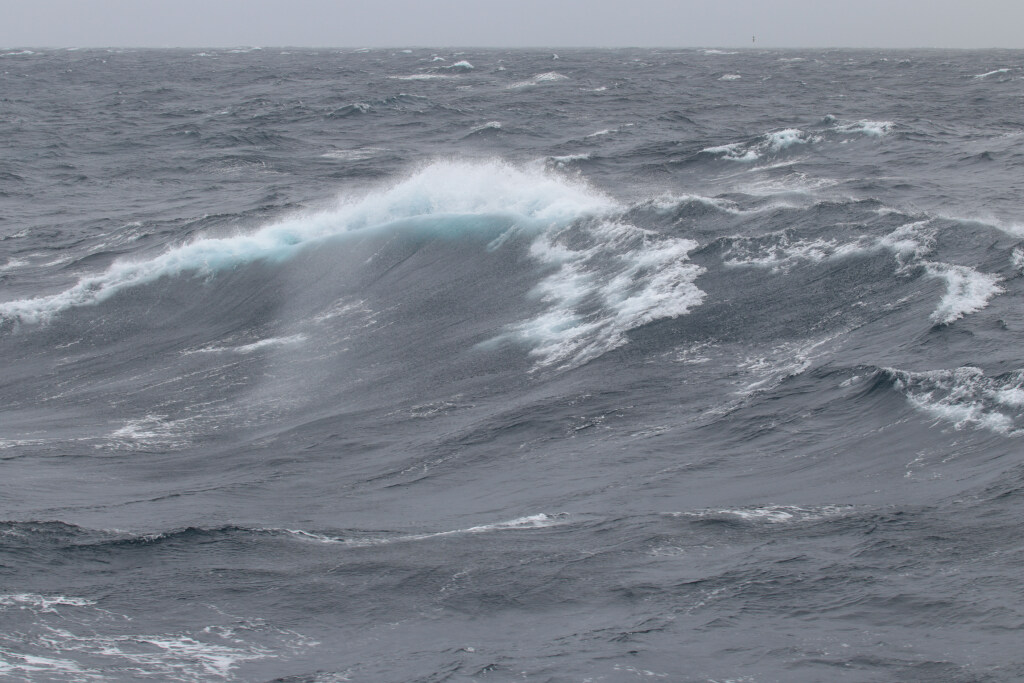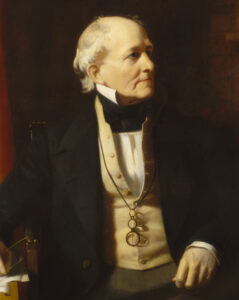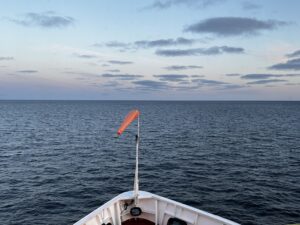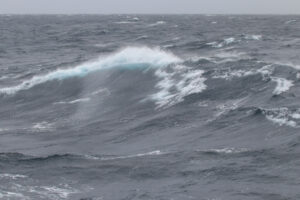
Wavelets and White Horses: The Beaufort Scale Explained
On a recent ship-to-shore broadcast, one of the JOIDES Expedition 400’s ice navigators was asked about the challenges posed by rough seas. He mentioned “white horses,” a nautical term for what landlubbers commonly call white caps. Sailors in polar seas care about them because they can conceal smaller icebergs, also known as “growlers.” White horses are also associated with the Beaufort scale, an essential guideline for the visual estimate of wind speed.
What’s the Beaufort Scale?
Officially, it’s called the Beaufort Wind Force Scale, but there’s usually no need to be so formal. It’s a way to measure and describe wind speed and its effects on the ocean. It helps sailors, meteorologists and adventurers understand and communicate the conditions they’re dealing with.
The JOIDES Ice navigator, Victor Gronmyr, explained that the Beaufort Scale “was a way to categorize something that everyone had a different opinion about.”

Who is Beaufort, and why does he get a scale named after him?
Ahh, Admiral Sir Francis Beaufort! A remarkable cipher of a man, he was born in Ireland in 1774 and joined the British Royal Navy as a teenage midshipman. At the time, sailors made regular weather observations, but they lacked a standard scale. As noted on Wikipedia, a “stiff breeze” to one, might be another’s “soft breeze.” As an officer, Beaufort standardized the scale, which has since evolved and included contributions from others.
The scale was used informally by sailors since Beaufort developed it in 1805. The Beaufort Scale was adopted officially and first used on Charles Darwin’s famed scientific expedition on the HMS Beagle.
How does this scale work, anyway?
It’s all about observations! You look at the sea’s surface and how it behaves. Beaufort’s Scale ranges from 0 to 12, with 0 being calm and 12 a full-blown hurricane. The National Oceanic and Atmospheric Administration’s website details the many different personalities that waves can express. The description for “Beaufort 3” nearly reads like a haiku:
“Large wavelets.
Crests begin to break.
Foam of glassy appearance.
Perhaps scattered white horses.”
At Beaufort 8, you’d be holding onto your hat with gale-force winds, high waves, foam, and “spindrift,” or spray everywhere.
What if you don’t have a fancy wind speed measuring device?
Beaufort’s Scale is super user-friendly. You can estimate the wind speed just by observing how the wind affects the water and nature around you. A windsock at the bow of a ship can give you a sense of how strong the wind is.

The simple genius of the scale means that it’s employed today by sailors, fishermen, meteorologists, kite surfers, and anyone who spends time near the water.
Do the JR navigators rely on the Beaufort Scale?
Expedition 400 Captain Harm Nienhuis says that he uses the scale, “all of the time,” to talk about the wind, though he notes that he would, for instance, say “Force 5” instead of “Beaufort 5.”’
Force 5 means moderate waves and many white horses, though it can sound more alarming to some.
“When I hear ‘Force 5’ I think that sounds horrible,” Operation’s Superintendent, Bill Rhinehart said. “I’m from Texas so the first thing I think is ‘category five,’ as in hurricane.”
Hurricane force winds are indeed covered by the Beaufort Scale, as it tops out, at 12.

Can Expedition 400 expect higher Beaufort numbers?
Fortunately, for most of our time in Baffin Bay, the JR has languished in Beaufort 3 seas. Our transit back to Reykjavik takes us around the southern tip of Greenland and north towards Iceland where the water, Captain Nienhuis says matter-of-factly, “could be more energetic.”
Meaning, the white horses could be out of the corral and galloping free.
Stay tuned for a Beaufort Scale update on our transit back!
Sources Used for this Article:
NOAA and National Weather Service: https://www.weather.gov/mfl/beaufort
Royal Meteorological Society, Met Matters, The Beaufort Scale: https://www.rmets.org/metmatters/beaufort-wind-scale